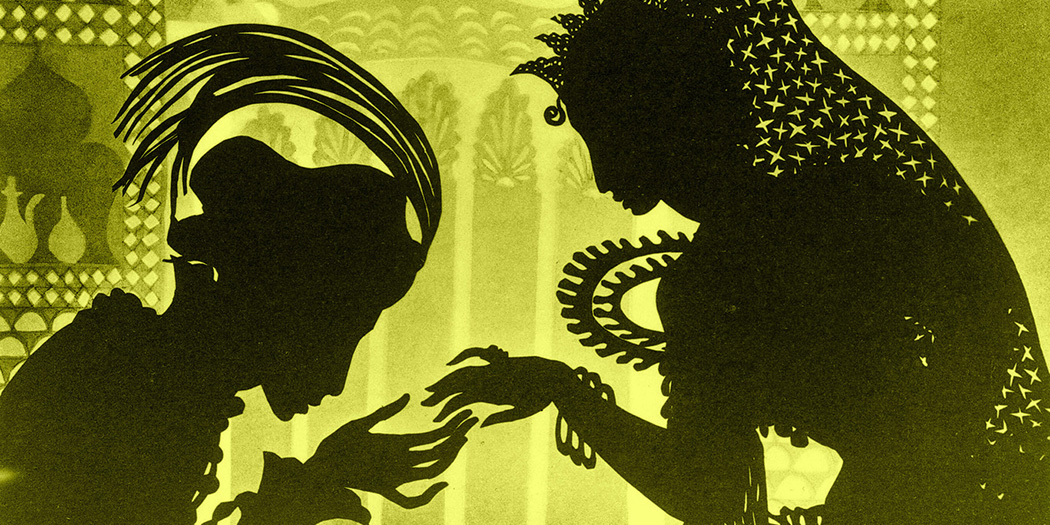
Inspired by the peculiarity of Nightmare Classic, section dedicated to cinema's past, the proposal of XVI edition consists of a film whose historical value is as great as its beauty. It's the case of The Adventures of Prince Achmed, dating back to the beginning of the century and directed by Lotte Reininger, one of the few women who wrote the history of cinema, who is considered the pioneer of silhouette film.
Inserted in the wonderful frame of the Golden Night 2018, the film is presented on the occasion of special event Nightmare&Dreamers, realised thanks to the well established collaboration with Circolo Sogni "Antonio Ricci".

The story is based on tales from the Arabian Nights. A miraculous flying horse made of wood is presented to the Caliph by a wicked sorcerer. In return he claims the Caliph's beautiful daughter, Dinarsade. Her brother, Prince Achmed, who is doubtful of the sorcerer's power leaps on the horse which promptly flies off with him.
Prince Achmed reaches the magical islands of Wak-Wak where he discovers a race of lovely bird princesses and falls in love with their leader, Peri Banu. But she is stolen from him by the sorcerer and Achmed is imprisoned on a fiery mountain, during Peri Banu is sold to the Emperor of China who gives her in marriage to a hideous dwarf. At last Achmed is rescued by an ogress - sworn enemy of the sorcerer - who equips him with magic armour and transports him to China. He reaches Peri Banu but she is snatched from him by the Djinns and Afreets of Wak-Wak who carry her off.
Achmed follows and on the way saves a young man from a monster. The man's name is Aladdin and they discover that by a strange coincidence he is married to Achmed's sister Dinarsade. This has been done with the help of a wonderful magic lamp which Aladdin had stolen from the wicked sorcerer. But the sorcerer had stolen the lamp back und had spirited away both Aladdin's wonderful palace and his wife Dinarsade.
The ogress joins Achmed and Aladdin; she summons up the sorcerer and kills him, thus gaining the magic lamp. Together they attack the Djinns and after a fierce struggle defeat them and rescue Peri Banu. Aladdin's castle floats down to them with Dinarsade still safely inside and the two happy couples say goodbye to the ogress and fly back to Baghdad.
The silhouette film Die Abenteuer des Prinzen Achmed - one of the first full-length animation films in the history of cinema - was made between 1923-1926. Lotte Reiniger and her husband, Carl Koch, as well as several of the leading artistic innovators of this period (Walther Ruttmann, Berthold Bartosch, Alexander Kardan), took several tales from the Arabian Nights, retained their beauty, comedy and even violence and combined them with the technical resources of the cinema.
Although Prince Achmed's first success was in France (after the first screening in Berlin in May 1926), the film is recognised as an unique product of the Golden Age of the German cinema. It was made in a very small garden studio in Potsdam on the estate of Louis Hagen, a young Berlin banker and supporter of the Arts, who had seen some of Reiniger's previous work. Die Abenteuer des Prinzen Achmed is an exciting and magical fantasy which manages to retain the original atmosphere of the Arabian legends, interpreted through the cinema screen.
The original negative was destroyed in Berlin towards the end of the War along with much else of Reiniger's work. Luckily an all-but complete nitrate positive had been preserved in the Archive of British Film Institute and new prints were taken from this copy. 1999 (as a tribut to Lotte Reiniger's 100. birthday anniversary) the film was restored by the Deutsches Filmmuseum in Frankfurt, with German language intertitles copied from Germaine Dulac's original designs.

Lotte Reiniger, 1899 born in Berlin, was one of the first artists to exploit the technique of the animated film. Her first film, Das Ornament des verliebten Herzens, was completed in 1919. Working in Berlin in the early Twenties she developed her own system of articulated cardboard forms animated directly under the cameras, producing silhouette figures with an incredible delicacy and individuality. She was assisted by her husband Carl Koch and later to work with Jean Renoir in France. In 1934 Lotte Reiniger, like many of the most creative German filmmakers, left Germany to settle in England where she joined the thriving avant garde G.P.O. Film Unit. After a successful live B.B.C. television series of shadow plays, she produced with Primrose Productions in 1954 a series of films based on traditional fairytales which are still being shown all over the World. One of them, The gallant little tailor, won the first prize at the Venice Film Festival of 1955.
Lotte Reiniger's figures and designs are created by free-hand scissor cutting. The depth and delicate tones of the backgrounds, made from varying layers of tissue paper, are photographed on a horizontal glass plate lit from below. Different figures are made for close-ups and long shots - the detail and silhouette in each case being subtly different. Her recent films are shot in colour and she uses gradations of coloured gelatine to obtain the landscape effects. Lotte Reiniger's art is unique, a source of eternal fascination.
Lotte Reiniger died at the age of 82 in June 1981 in Dettenhausen near Tübingen where she spent the last months of her life. The complete work of Lotte Reiniger contains about 40 silhouette films.